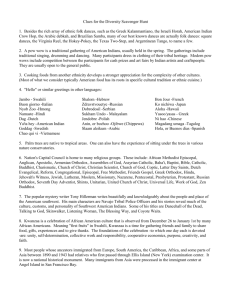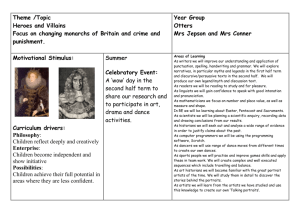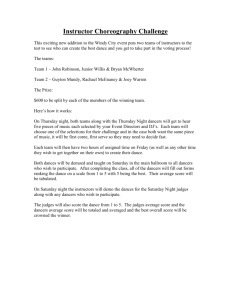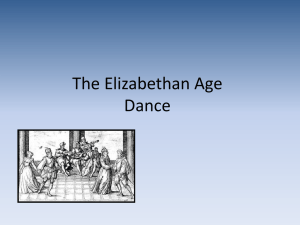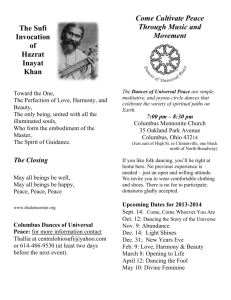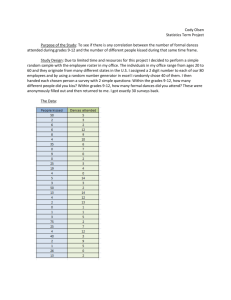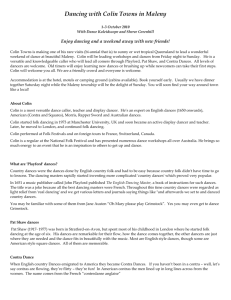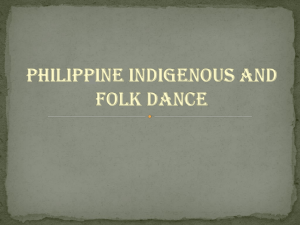aesthetic assessment of folk dances
advertisement
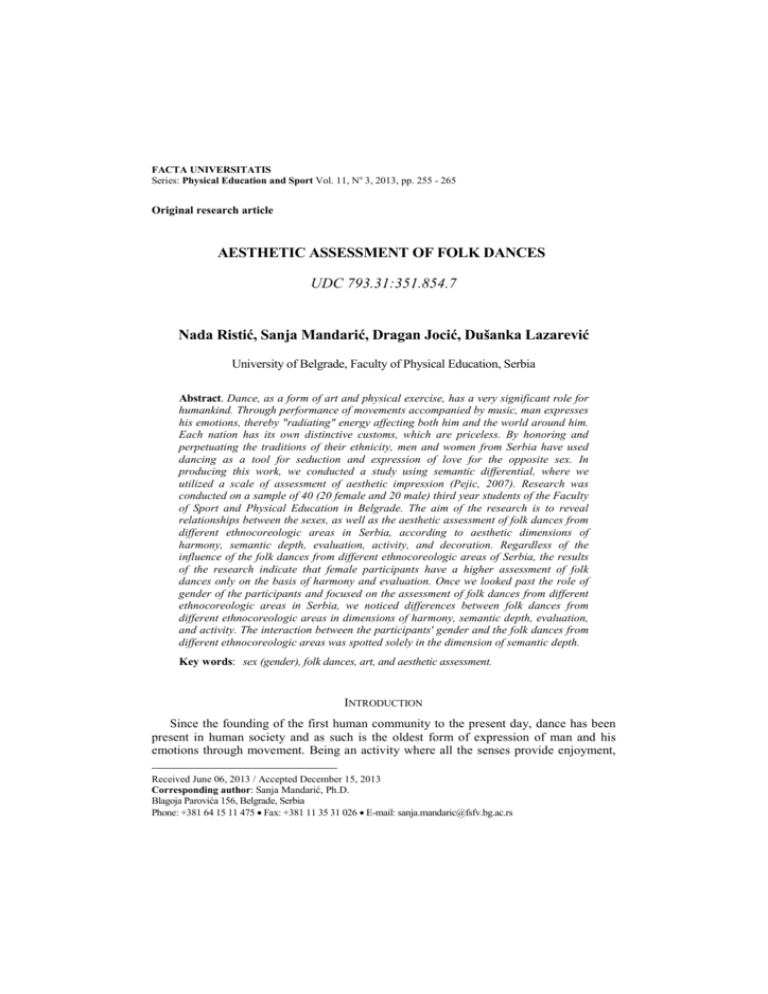
FACTA UNIVERSITATIS Series: Physical Education and Sport Vol. 11, No 3, 2013, pp. 255 - 265 Original research article AESTHETIC ASSESSMENT OF FOLK DANCES UDC 793.31:351.854.7 Nada Ristić, Sanja Mandarić, Dragan Jocić, Dušanka Lazarević University of Belgrade, Faculty of Physical Education, Serbia Abstract. Dance, as a form of art and physical exercise, has a very significant role for humankind. Through performance of movements accompanied by music, man expresses his emotions, thereby "radiating" energy affecting both him and the world around him. Each nation has its own distinctive customs, which are priceless. By honoring and perpetuating the traditions of their ethnicity, men and women from Serbia have used dancing as a tool for seduction and expression of love for the opposite sex. In producing this work, we conducted a study using semantic differential, where we utilized a scale of assessment of aesthetic impression (Pejic, 2007). Research was conducted on a sample of 40 (20 female and 20 male) third year students of the Faculty of Sport and Physical Education in Belgrade. The aim of the research is to reveal relationships between the sexes, as well as the aesthetic assessment of folk dances from different ethnocoreologic areas in Serbia, according to aesthetic dimensions of harmony, semantic depth, evaluation, activity, and decoration. Regardless of the influence of the folk dances from different ethnocoreologic areas of Serbia, the results of the research indicate that female participants have a higher assessment of folk dances only on the basis of harmony and evaluation. Once we looked past the role of gender of the participants and focused on the assessment of folk dances from different ethnocoreologic areas in Serbia, we noticed differences between folk dances from different ethnocoreologic areas in dimensions of harmony, semantic depth, evaluation, and activity. The interaction between the participants' gender and the folk dances from different ethnocoreologic areas was spotted solely in the dimension of semantic depth. Key words: sex (gender), folk dances, art, and aesthetic assessment. INTRODUCTION Since the founding of the first human community to the present day, dance has been present in human society and as such is the oldest form of expression of man and his emotions through movement. Being an activity where all the senses provide enjoyment, Received June 06, 2013 / Accepted December 15, 2013 Corresponding author: Sanja Mandarić, Ph.D. Blagoja Parovića 156, Belgrade, Serbia Phone: +381 64 15 11 475 Fax: +381 11 35 31 026 E-mail: sanja.mandaric@fsfv.bg.ac.rs 256 N. RISTIĆ, S. MANDARIĆ, D. JOCIĆ, D. LAZAREVIĆ dance is psychologically and physically relaxing, simultaneously developing hearing, a sense of rhythm and music, and raising levels of general culture (Jocic, 1999). With its dynamics and diverse content, it easily gathers and draws people together regardless of their social standing and gender. Each ethnic group has their folk dance which originated in accordance with their way of life and the culture of that group. The value of folk dance is great, as it preserves the tradition and culture of the people. The main characteristic of Serbian folk dances is the simultaneous participation of a multitude of dancers. According to Zecevic (1981), folk dances may be danced in formation consisting of: an unlimited number of interconnected dancers performing the dance together (kolo and lesa), or, a limited number of dancers, divided into specific groups making separate entities (solo dance, dancing in pairs, dancing in threes, dancing in fours). Serbian folk dances are numerous and versatile, and they are systematized in multiple ethnocoreologic areas based on their correlation, basic style, rhythmical, spatial and other characteristics. In Serbia, there are several larger ethnocoreologic areas where dances are performed in a similar fashion, though each area has a unique and distinct style of dancing. According to Zecevic (1983), there are six ethnocoreologic areas which are characterized by a specific style of dancing: Pannonian ethnocoreologic area, ethnocoreologic area of Central Serbia, ethnocoreologic areas of Western Serbia, ethnocoreologic area of Southern and Southeastern Serbia, ethnocoreologic area of Kosovo, and ethnocoreologic area of Eastern Serbia. This research applied stimulants in the form of videos of folk dances from the Pannonian ethnocoreologic area, Central Serbia, and Southern and Southeastern Serbia. The Pannonian ethnocoreologic area, a separate choreographic area represented by Vojvodina, is characterized by small steps, almost stationary dancing, where the heels are never too far from the ground. This style of dancing is characteristic of female dancers. A similar style with individual improvisation with decorative steps and figures is especially pronounced in male dance. A characteristic improvisation is syncopesque stomping with heels, or heel on heel clicks. Of all the dance varieties, kolo is the most widespread, and it can be open or closed. The kolo is followed by dancing in pairs, which in turn is followed by dancing in threes. Vojvodina also has solo dances, where the best dancers compete as they show off their skills. Posture during dancing varies. Dancing used to be accompanied by bagpipes, whereas today they are most often accompanied by mandolins, and there is also plenty of dancing to vocal accompaniment. Ethnocoreologic area of Central Serbia, representing Sumadija, is characterized by dancing with a relaxed body and bent knees and gentle fluttering along the vertical axis. Sumadija's dancing style is distinctive in the fact that it presents small steps and fine body quivers caused by soft movement in the knees, which brings a joyful feeling to many a kolo. Dancers dance on the front of their feet, and the basic steps are characterized by numerous varieties performed in a series of showboating intertwining steps. The basic dance form is the kolo, while there are also, though rarely, the closed kolo and lesa. Most dances are performed in an open kolo, to the sound of svirels, flutes, or double svirels. Male and female dancers are positioned alternately. They are equals within the kolo, and hold each other's hand (more rarely each other's belts). Background music may be instrumental, instrumental-vocal, or vocal. Ethnocoreologic area of Southeastern and Southern Serbia has a style recognizable by pronounced body vibration, a result of bent knees, which extend fully only for brief Aesthetic Assessment of Folk Dances 257 moments. The body is upright and in constant gentle up and down quiver, giving the impression that the feet never leave the ground. Dancing is performed on full feet, powerfully and sharply. Sopluk exhibits especially powerful dancing, while Vranje exhibits exceptionally firm, but smoother and calmer dancing (Jocic, 1999). They mostly hold each other by the belt, or alternatively, by their scarves or hands elevated to shoulder level. Dances are performed in mixed-gender kolo or lesa with orchestral backup. Male and female dancers often dance in separate lesa simultaneously or alternately, using their dance to seduce the opposite sex. Dance and music style usually mirror each other, notwithstanding exceptions with outside influences. Folk dances are a vessel for the individual to express his/her emotions through movement. All performed movements in every dance, folk dances included, have an aesthetic purpose. The aesthetic dimension is one of the most important ones, because dances represent a source of aesthetic urges and feelings. Dances provide the possibility for humans to aesthetically shape themselves, or enjoy other aesthetic forms such as harmony. Aesthetic means are the final form of dance expression (Kostic & Uzunovic, 2012, p. 13). Aesthetically molded movement is a 'beautifully' performed movement. However, the term beautiful cannot be precisely defined, as it depends on numerous factors. Aesthetics, as a branch of philosophy, considers art as a special form of human creativity. It explores the beautiful and valuable in art, the essence of artistic creation and impression of a work of art. In art, psychology and experimental aesthetics there are numerous studies exploring various characteristics of aesthetic stimuli, starting with the assumption that some of them affect aesthetic assessment. Although they are not numerous, studies in aesthetic assessment and dance impression are of a recent date. Research from Serbia has shown that participants make distinctions in aesthetic assessment of different types of dance. The study carried out by Vukadinovic (2010) has noted that classical ballet and flamenco are judged very highly on the dimension of harmony; flamenco and modern ballet scored high for semantic depth and decoration; flamenco scored high in the dimension of evaluation, while modern ballet scored high in the dimension of activity. Similar results were obtained by Pflug (2011), indicating that classical ballet is rated more highly in the dimensions of harmony and evaluation, while modern ballet rates higher in dimensions of decoration and depth. Mandaric and Pflug's (2012) aesthetic assessment of social dance indicates that Latino dances are assessed more as dynamic, rhythmical, powerful, and versatile when compared to standard dances, while standard dances are deemed more as timid and appealing than Latin American dances. Unlike other artistic disciplines, dance is characterized by specific features including the fact that dancers do not create in the same medium through which spectators receive their work of art (Arnheim, 1966) and that dance is spatially and temporally defined (Laban, 1960; McFee, 1992; Layson, 1994; Hutchinson-Guest, 2009), which means that the role of proprioceptive and exteroceptive senses in the aesthetic experience of dance is different. Vukadinovic and Markovic's (2011) research includes the construction of an instrument for measuring the aesthetic experience of dance performances and the investigation of the structure of both the dancers' and spectators' aesthetic experience. The research was carried out during eight different performances of various dance forms, including classical ballet, contemporary dance, flamenco and folklore. Three factors of aesthetic experience of dance performances were identified: Dynamism, Exceptionality and Affective Evaluation. The results show that the dancers' aesthetic experience has a 258 N. RISTIĆ, S. MANDARIĆ, D. JOCIĆ, D. LAZAREVIĆ somewhat different factorial structure from that of the spectators'. Unlike the spectators' aesthetic experience, the dancers' aesthetic experience singles out the Excitement factor. The results are discussed within the context of the dancers' proprioception and spectators' exteroception since these findings confirm the idea of a significant role of proprioception in the dancers' aesthetic experience. Visual arts research on the effects of gender to aesthetic assessment of works of art shows no agreement in the obtained results. Earlier research indicates that females possess more aesthetic sensibility (Eysenck & Castle, 1970; Chan, Eysenck, and Götz, 1980; Frois & Eysenck, 1995) or are artistically more inclined (Frumkin, 1963). Research in dance has shown that the participants' gender affects the aesthetic assessment of dance. Pflug (2011) has conducted a study establishing the role gender plays in the aesthetic assessment of ballet. The results have confirmed that the participants' gender affects the aesthetic assessment of dance. Female students assess ballet as more harmonious, precise, gentle, appealing, fluttering, complex, and diverse than male students. When it comes to impressions on various kinds of ballet, female participants rank classic ballet higher in dimensions of semantic depth, evaluation, and decoration. Male participants likewise assess classic and modern ballet differently in dimensions of semantic depth and evaluation. They rate modern ballet more highly in terms of semantic depth, while they value classic ballet more highly on the dimension of evaluation. This shows that female and male participants view dance differently, which explains their varying assessments of modern and classic ballet. Pflug and Pejic (2011) ascertain that the participants' sex influences their aesthetic assessment of dance. Ballerinas' performances in classic ballet are characterized by gentleness and appeal, whereas the male dancers' are valued for diversity, complexity, mystique, and strength. Assessments of modern ballet are quite the opposite. Ballerinas' performances are viewed as having mystique and powerful, whereas the male dancers' are viewed as harmonious, precise, gentle, and appealing. Just as in the aesthetic assessment of ballet, it is evident that the aesthetic assessment of social dances is heavily influenced by the participants' sex. Females assess social dances as more harmonious, precise, powerful, mystical, dynamic, rhythmical, fluttering, diverse, and lavish than male participants do (Pflug, Mandaric, 2012). Folk dances were not part of the research in experimental aesthetics, in spite of the wealth of tradition in Serbia. The subject matter of this research was the study of the correlation between the gender of the participants and their aesthetic assessment of folk dances. The aim of the research was to establish the connection between the participants' sex and aesthetic assessment of folk dances in the aesthetic dimensions of harmony, semantic depth, evaluation, activity, and decoration. THE METHOD The sample of participants The research was conducted on 40 (20 females and 20 males) third year students of the Faculty of Sport and Physical Education of the University of Belgrade, who had achieved general knowledge about folk dances after attending theoretical and practical lectures the Theory and Methodology of Dances class. Aesthetic Assessment of Folk Dances 259 The sample of variables In the study, the scale for the assessment of aesthetic impression (Pejic, 2007; Pejic, Milicevic, 2007) was used, which consists of 15 seven-grade scales in the form of a semantic differential. The scales measured 5 dimensions: harmony (scales: connected, precise, harmonious, and their opposites), semantic depth (scales: odd, powerful, mystical, and their opposites), evaluation (scales: appealing, shy, gentle, and their opposites), activity (scales: dynamic, rhythmical, fluttery, and their opposites), and decoration (scales: lavish, diverse, complex, and their opposites). The variable sample was represented by: independent variables – the participants' gender and the type of folk dance, and dependent variables – dimensions of harmony, semantic depth, evaluation, activity, and decoration. Research protocol At the beginning of the experiment, the participants were given scales for assessing aesthetic impression, after which they were given instructions on videos and how to grade scales. The participants had 9 2-minute videos of folk dances, three apiece from each ethnocoreologic area (Pannonian, Central Serbia, and Southern and Southeastern Serbia), played to them on an LCD projector. Folk dances in the videos were excerpts from wellknown choreographies performed by dancers from professional dance troops from Serbia. The participants were tasked with assessing each stimulus on all 15 scales, immediately after watching each video clip. There was no time limit for the assessments. Statistical processing of the data Using the technique of analysis of variance for repeated measurements, how each of the independent variables (subject's sex and type of folk dance) affects each of the five dependent variables (dimensions of harmony, semantic depth, evaluation, activity and decorations) was studied, as well as whether there is any interaction between the mentioned independent variables. Statistical data processing was performed using the SPSS statistical program. RESULTS The results of the research, shown in Table 1, indicate the influence of the independent variables and their interaction with the dependent variables. Table 1 The analysis of variance for repeated measures shows the effect of the independent variables and their interactions on the dependent variables Dependent variables Harmony Semantic depth Evaluation Activity Decoration Sex of the respondents DF F Sig 1,38 4,876 0,033 1,38 0,025 0,874 1,38 10,493 0,002 1,38 0,225 0,638 1,38 2,488 0,090 Type of dance Sex – type interaction DF F Sig DF F Sig 2,76 6,432 0,003 2,76 1,222 0,300 2,76 10,388 0,000 2,76 3,765 0,028 2,76 9,075 0,000 2,76 0,397 0,674 2,76 3,807 0,027 2,76 2,864 0,063 2,76 3,362 0,262 2,76 0,590 0,447 260 N. RISTIĆ, S. MANDARIĆ, D. JOCIĆ, D. LAZAREVIĆ The analysis of variance for repeated measures (Table 1) indicates that, in the dimension of harmony there is a statistical significance in the basic effects of the participants gender F (1.38) = 4.876, p<.05 and type of folk dance F (2.76) = 6.432, p<.05. The interaction between the participants' gender х, the type of folk dance in the dimension of harmony is not statistically significant F (2.76) = 1.222, p>.05. In the dimension of semantic depth, the statistical significance was observed in the basic effect of the type of folk dance F (2.76) = 10.388, p<.05, while the basic effects of the participants' gender were insignificant F (1.38) = 0.025, p>.874. The interaction between the participants' gender х, the type of folk dance in the dimension of semantic depth was statistically significant F (2.76) = 3.765, p>.05. The research results in the dimension of evaluation indicate that there is a statistical significance in the basic effect of participants' gender F (1.38) = 10.493, p<.05 and type of folk dance F (2.76) = 9.075, p<.05. The interaction of the participants' gender х, type of folk dance in the dimension of evaluation has not reached statistical significance F (2.76) = 0.397, p>.05. In the dimension of activity, a statistical significance was observed in the basic effect of the type of folk dance F (2.76) = 3.807, p<.05, while the basic effect of the participants' gender F (1.38) = 0.225, p>.05 and interaction between the participants' gender х, type of folk dance F (2.76) = 2.864, p>.05 were not registered as significant in the dimension of activity. When the research results of in the dimension of decoration were analyzed, it was evident that there was no statistical significance of the basic effects of the participants' gender F (1.38) = 2.488, p>.05, type of folk dance F (2.76) = 3.362, p>.05, as well as the interaction between the participants' gender х, type of folk dance F (2.76) = 0.590, p>.05. The basic effect of the participants' gender in the dimension of harmony is evident in the fact that female participants assess folk dances as significantly more connected, and as more precise and harmonious, in comparison to male participants. In the dimension of evaluation, the female participants assess folk dances as significantly more appealing, timid, and gentler as opposed to the male participants (Graph 1). Graph 1 The participants' assessments based to gender on the dimensions of harmony and evaluation Aesthetic Assessment of Folk Dances 261 The basic effect of the type of folk dance on dimensions of harmony, semantic depth, evaluation, and activity is shown in graph 2. Graph 2 The participants' assessments according to type of folk dance on the dimensions of harmony, semantic depth, evaluation, and activity. The results of the basic effect of the type of folk dance on the dimension of harmony (Graph 2) indicate that both the male and female participants assess dances from the Central Serbia ethnocoreologic area as the most connected, precise, and harmonious. Dances from the Pannonian ethnocoreologic area have been assessed as least connected, least precise, and least harmonious, while dances from the Southeastern and Southern Serbia ethnocoreologic area were assessed in between the previous two. Folk dances from the Southeastern and Southern Serbian ethnocoreologic area show no statistically significant difference in comparison to the other two ethnocoreologic areas. The basic effect of the type of folk dance on the dimension of semantic depth (Graph 2) indicates that all the participants have assessed dances from the Pannonian ethnocoreologic area as the oddest, most powerful, and most mystifying. Dances from the ethnocoreologic area of Central Serbia have been assessed as the least strange, least powerful, and least mystifying. Dances from Southeastern and Southern Serbia ethnocoreologic area have been assessed in between them. Folk dances from the Southeastern and Southern Serbian ethnocoreologic area show no statistically significant difference in comparison to the other two ethnocoreologic areas. The basic effect of the type of folk dance on the dimension of evaluation (Graph 2) indicates that both the male and female subjects assess dances from Southeastern and Southern Serbian ethnocoreologic area as the most appealing, most timid, and gentle. Dances from the Pannonian ethnocoreologic area have been assessed as least appealing, least timid, and least gentle, while dances from the Central Serbian ethnocoreologic area were assessed in between the previous two. Folk dances from the Central Serbian ethnocoreologic area show no statistically significant difference in comparison to the other two ethnocoreologic areas. 262 N. RISTIĆ, S. MANDARIĆ, D. JOCIĆ, D. LAZAREVIĆ The dimension of activity offers results on the basic effect of the type of folk dance (Graph 2) indicating that all the participants assess dances from the Central Serbia ethnocoreologic area as the most dynamic, rhythmical, and fluttering. Dances from the Pannonian ethnocoreologic area have been assessed as less dynamic, less rhythmical, and less fluttery, while dances from the Southeastern and Southern Serbia ethnocoreologic area were assessed as least dynamic, least rhythmical, and least trembling. Folk dances from the Pannonian ethnocoreologic area show no statistically significant difference in comparison to the other two ethnocoreologic areas. The effects of the interaction between the type of folk dance and the participants' gender on the dimension of semantic depth are shown in graph 3. The female participants assessed dances from the Central Serbian ethnocoreologic area as the least strange, least powerful, and least mysterious in comparison to the dances from the Pannonian and Southeastern and Southern Serbian ethnocoreologic areas. The male participants have assessed dances from the Pannonian ethnocoreologic area as the oddest, most powerful, and most mystical when compared to dances from the .Central Serbian and South-eastern and Southern Serbian ethnocoreologic areas. Graph 3 The interaction between the participants' gender and the type of folk dance in the dimension of semantic depth DISCUSSION In observing solely the influences of the participants' gender on the aesthetic impression of folk dance while looking past the influence of the type of folk dance, a partial difference between the assessments of the male and female participants was observed. The female participants assess folk dances higher than males only in dimensions of harmony and evaluation. This means that female participants assess folk dances as more connected, precise, harmonious, appealing, and gentler than male students. The obtained results are not in accordance with previous research which indicates that the female participants are generally more inclined to art (Frumkin, 1963), as well as Aesthetic Assessment of Folk Dances 263 higher aesthetic sensibility (Eysenick & Castle, 1970; Chan, Eysenick, and Götz, 1980; Frois and Eysenick, 1995). Pflug (2011) also obtained results indicating that women assess ballet significantly higher than men do, which is evident in the dimensions of: harmony, evaluation, activity, and decoration. Once we look beyond the role of the participants' gender and observe solely assessments of the type of folk dance, a difference in the aesthetic assessments of dances from various ethnocoreologic areas was registered. Differences were observed in the following dimensions: harmony, semantic depth, evaluation, and activity. Dances from Sumadija scored the highest in the dimension of harmony, followed by dances from South-eastern and Southern Serbia, with dances from Vojvodina being assessed with the lowest scores. This indicates that the participants assess dances from Sumadija as the most connected, precise, and harmonious. This is easily explained with the fact that dances from Sumadija are most commonly performed in open mixed kolo and that choreographies are designed in such a way as to have folk dances changing in quick succession. Dances from Vojvodina were assessed as the least connected, least precise, and least harmonious. This is due to the way that dances in the Pannonian ethnocoreologic area are performed, where, during a single dance, there are often changes of body position of the dancers on stage. The dances are broken up by solo performances of certain dancers, the fact that influenced the participants to rate these dances lowest in the dimension of harmony. Dances from Southeastern and Southern Serbia were assessed in between the two other ethnocoreologic areas on the dimension of harmony. A dominant feature for dances from this ethnocoreologic area is that male and female dancers dance alternately. Dances from Vojvodina were assessed the highest on the dimension of semantic depth, while dances from Sumadija were assessed the lowest, which is contrary to the assessments in the dimension of harmony. Dances from South-eastern and Southern Serbia were again assessed in between on the scale of semantic depth. The results indicate that dances from Vojvodina were assessed as the oddest, most powerful, and most mysterious. A certain degree of representation of acrobatics, acting, and influence of folklore of ethnic minorities living in Vojvodina makes these dances more mysterious and diverse than dances from other ethnocoreologic areas. On the dimension of evaluation, the dances from Southeastern and Southern Serbia were assessed the highest by the participants, followed by dances from Sumadija, with dances from Vojvodina coming in last. This is to say that dances from Southeastern and Southern Serbia are the most appealing, most timid, and gentle. These results are explained with the way dances from Southeastern and Southern Serbia are performed. Male and female dancers often dance alternately in separate lesa. Dances are full of local customs, with the tempo changing from steady to rapid, leaving an impression on the observers. On dimension of activity, dances from the Central Serbian ethnocoreologic area were assessed as the most dynamic, rhythmical, and fluttering. The results follow the characteristics of the Central Serbia ethnocoreologic area. Dancers from this area dance on the front of their feet with bodies fluttering. The music has higher tempo and it matches the dancing. Dances from the Pannonian ethnocoreologic area were assessed as less dynamic, less rhythmical, and less fluttering, while dances from Southeastern and Southern Serbia ethnocoreologic area were assessed as least dynamic, least rhythmical, and least fluttering. In this study, the interaction between the participants' gender and type of folk dance was observed only in the dimension of semantic depth. Thus, on this dimension, dances from different ethnocoreologic areas were assessed differently by the male and female 264 N. RISTIĆ, S. MANDARIĆ, D. JOCIĆ, D. LAZAREVIĆ participants. The male participants have assessed dances from Vojvodina as the strangest, most powerful, and most mysterious in comparison to dances from Sumadija and those from Southeastern and Southern Serbia. The female participants have assessed dances from Sumadija as least strange, least powerful, and least mysterious in comparison to the dances from Southeastern and Southern Serbia and dances from Vojvodina. These results can be explained by the way dancing and choreography is performed in these ethnocoreologic areas. Dances from Vojvodina are mostly performed in pairs with solo elements. They are acrobatic in character and are performed as a form of competition and a means to showcase the abilities of an individual. The influence of ethnic minorities is also present, thus the dances contain customs of these peoples. Dances from Sumadija are different in character. They are performed in succession, one after the other, without the portrayal of the customs of people from Central Serbia. CONCLUSIONS In general, we may conclude that the research that was carried out indicates that the independent variable – type of folk dance, influences a large number of dependent variables in relation to the independent variable – the participants' gender. Types of folk dance were assessed differently on dimensions of harmony, semantic depth, activity, and evaluation, while differences in gender were only observed for the dimensions of harmony and evaluation. The female participants assess folk dances as more connected, precise, harmonious, appealing, timid, and gentler. Interaction between the participants' gender and the type of folk dance was observed solely on the dimension of semantic depth. The abovementioned indicates that the obtained results partially coincide with results from previous studies. One should keep in mind that folk dances of Serbia, just as other dances, represent a complex and diverse area. They are preconditioned by many factors: geographical, economic, social, and cultural. Thus, the aesthetic assessment of dances and other works of art is largely dependent on who is assessing the artwork, which culture that person comes from, as well as on many other factors. This may create an incentive for continued research in the area, as well as for making comparisons between different types of dances. REFERENCES Arnheim, R. (1966). Towards a Psychology of Art, Collected Essays. Berkeley-Los Angeles: University of California Press. Chan, J., Eysenick H. J. & Götz, K. O. (1980). A new visual aesthetic sensitivity test: III Cross-cultural comparison between Hong Kong children and adults, and English and Japanese samples. Perceptual and Motor Skills, 50 (3c), pp. 1325-1326. Eysenick, H. J. & Castle, M. (1970). Training in arts as a factor in the determination of preference judgments for polygons. British Journal of Psychology, 61 (1), pp. 65-81. Frois, J. P. & Eysenick, H. J. (1995). The visual aesthetic sensitivity test applied to Portuguese children and fine art students. Creativity Research Journal, 8 (3), pp. 277-284. Frumkin, R. M. (1963). Sex, familiarity and dogmatism as factors in painting preferences. Perceptual and Motor Skills, 17 (1), pp. 12-20. Hutchinson – Guest, A. (2009). Labanotation: the system of analyzing and recording movement. Philadelphia, PA: Taylor and Francis, Inc. Jocić, D. (1999). Plesovi. Beograd: SIA. Kostić, R., Uzunović, S. (2012). Ples. Niš: Fakultet sporta i fizičkog vaspitanja. Aesthetic Assessment of Folk Dances 265 Laban, R. (1960). Mastery of Movement. London: Macdonald and Evans. Layson, J. (1994). Historical perspectives in the study of dance. In J. Adshead – Lansdale & J. Layson (Eds.), Dance history an introduction, pp. 4–17. London & New York: Routledge. Mandarić, S., Pflug, A. (2012). Razlike u estetskoj proceni latino-američkih i standardnih plesova. Proceedings book of the Eighteenth International Symposium Empirijska istraživanja u psihologiji, (p. 17). Beograd: Institut za psihologiju i Laboratorija za eksperimentalnu psihologiju, Filozofski fakultet, Univerzitet u Beogradu. McFee, G. (1992). Understanding Dance. London & New York: Routledge. Pejić, B. (2007). Skala procene estetskog doživljaja. Proceedings book of the Thirteenth International Symposium Empirijska istraživanja u psihologiji, (p. 23). Beograd: Institut za psihologiju i Laboratorija za eksperimentalnu psihologiju, Filozofski fakultet, Univerzitet u Beogradu. Pejić, B., Milićević, N. (2007). Provera skale procene estetskog doživljaja. Proceedings book of the Symposium ''Empirijska istraživanja u psihologiji", (p.25). Beograd: Institut za psihologiju i Laboratorija za eksperimentalnu psihologiju, Filozofski fakultet, Univerzitet u Beogradu. Pflug, A. (2011). Razlike u estetskoj proceni klasičnog i modernog baleta. Proceedings book of the Seventeenth International Symposium Empirijska istraživanja u psihologiji, (p. 26). Beograd: Institut za psihologiju i Laboratorija za eksperimentalnu psihologiju, Filozofski fakultet, Univerzitet u Beogradu. Pflug, A. i Pejić, B. (2011). Uloga pola plesača u estetskoj proceni baleta. Proceedings book of the Seventeenth International Symposium 'Empirijska istraživanja u psihologiji, (p. 27). Beograd: Institut za psihologiju i Laboratorija za eksperimentalnu psihologiju, Filozofski fakultet, Univerzitet u Beogradu. Pflug, A., Mandarić, S. (2012). Uloga pola ispitanikau estetskoj proceni društvenih plesova. Proceedings book of the Eighteenth International Symposium ''Empirijska istraživanja u psihologiji'', (p. 18). Beograd: Institut za psihologiju i Laboratorija za eksperimentalnu psihologiju, Filozofski fakultet, Univerzitet u Beogradu. Vukadinović, M. (2010). Subjektivni doživljaj različitih tipova plesa. Proceedings book of the Sixteenth International Symposium ''Empirijska istraživanja u psihologiji'', (p. 10). Beograd: Institut za psihologiju i Laboratorija za eksperimentalnu psihologiju, Filozofski fakultet, Univerzitet u Beogradu. Vukadinović, M., Marković S. (2011). Aesthetic Experience of Dance Performance. Serbian Psychological Association, 25 (1), pp.23-41. Zečević, S. (1981). Srpske narodne igre. Beograd: Savez amatera Srbije. Zečević, S. (1983). Srpske narodne igre. Beograd: Vuk Karadžić. ESTETSKA PROCENA NARODNIH PLESOVA Ples, kao vrsta umetnosti i kao oblik fizičkog vežbanja, ima veoma značajnu ulogu za ljudski rod. Izvođenjem pokreta uz muziku, čovek izražava svoja osećanja, čime ''zrači'' energijom koja utiče na njega samog, ali i na svet oko njega. Svaki narod ima sebi svojstvene običaje, koji su od neprocenjive vrednosti. Poštujući i održavajući tradiciju svoga naroda, muškarci i žene sa područja Srbije su koristili ples kao sredstvo zavođenja i iskazivanja ljubavi prema suprotnom polu. Za potrebe ovog rada sprovedeno je istraživanje tehnikom semantičkog diferencijala, pri čemu je korišćena skala procene estetskog doživljaja (Pejić, 2007). Istraživanje je sprovedeno na uzorku od 40 studenata (20 ženskog i 20 muškog pola), treće godine Fakulteta sporta i fizičkog vaspitanja u Beogradu. Cilj istraživanja su relacije pola i estetske procene narodnih plesova, različitih etnokoreoloških područja Srbije, po estetskim dimenzijama sklada, semantičke dubine, evaluacije, aktiviteta i ukrasa. Zanemarujući uticaj narodnih plesova različitih etnokoreoloških područja Srbije, rezultati istraživanja ukazuju da, ispitanice više procenjuju narodne plesove od ispitanika samo na dimenzijama sklada i evaluacije. Kada se zanemari uloga pola ispitanika i posmatra samo procena narodnih plesova različitih etnokoreoloških područja Srbije, uočene su razlike između narodnih plesova različitih etnokoreoloških područja na dimenzijama sklada, semantičke dubine, evaluacije i aktiviteta. Interakcija između pola ispitanika i narodnih plesova različitih etnokoreoloških područja, zastupljena je samo na dimenziji semantičke dubine. Ključne reči: pol, narodni plesovi, umetnost, estetska procena.
